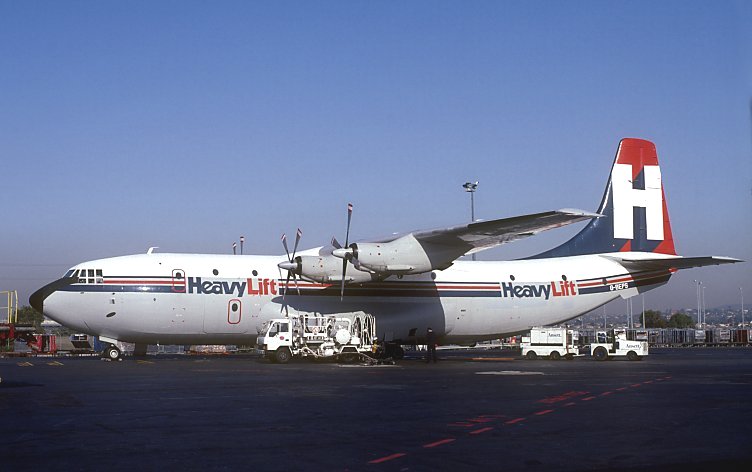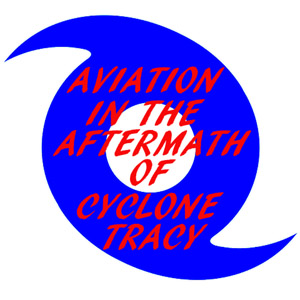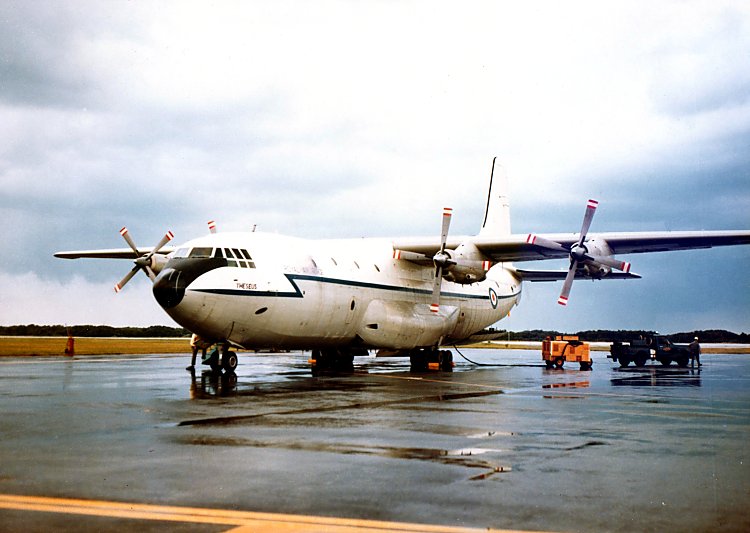|
In the weeks leading up to
Cyclone Tracy on Christmas Day 1974, a Royal Air Force Short Belfast
had been tasked to recover Rapier missile test equipment from the Woomera
rocket range for return to the UK. The return flight only got as far
as Darwin where the aeroplane went unserviceable, requiring an engine
change. The event is described in Molly O'Loughlin White's book Belfast
- The Story of Short's Big Lifter (Midlands Counties Publications,
England 1984):
"While the Belfasts
were flying in RAF colours, 150 engines were changed. The Tyne change
team, formed to assist in the rapid recovery of the Belfast from
far-away places when an engine failed, was also provided from the
line. One of its most memorable exploits was getting a Belfast airborne
before the path of the Darwin cyclone of 1974. The aircraft, delayed
ten days in Darwin after recovering Rapier test equipment from Woomera,
got away, but because of the devastation the unserviceable engine
was not brought home until the following May, over five months later.
"John Rhodes, a former crew chief on the Tyne team recalled:
The engine's waterproof cover was in shreds and it was covered
in red Darwin dust - but the biggest surprise was its lodger - a
small Australian tree frog which although it had an injured leg,
was still alive. The frog recovered and was presented to the Cotswold
Wild Life Park at Burford." |
Although
the book does not record the identity of the Belfast, the chance discovery
of a discarded file of signals from RAAF Darwin identifies the aeroplane
as "XL368". There was no Belfast with this serial but there
was a Belfast XR368 Theseus. That XR368 was indeed the aeroplane
involved has been confirmed by Jock Manson, then a Flight Lieutenant
on No. 53 Squadron, who was the co-pilot on XR368 when it departed from
its base at Brize Norton on 5 December 1974 under the command of Flight
Lieutenant Geoff Fentum. The aircraft routed via Akrotiri, Masirah,
Gan and Tengah where the crew changed. At Tengah, XR368 was taken over
by Flight Lieutenant "Bird" Peacock and his crew who were
to take the aeroplane to Woomera and back to Tengah.
Presumably the Rapier support equipment was loaded successfully at Woomera
and XR368 departed on its return flight to the UK. The aircraft arrived
at Darwin sometime around 10 December. During the take-off from Darwin,
one of the Rolls Royce Tyne engines failed and the take-off was abandoned.
With only two engines available for the application of symmetrical reverse
thrust, Standard Operating Procedures demanded full brakes. This resulted
in four mainwheels deflating when their fusible plugs operated as designed.
Meanwhile, Flt Lt Fentum and his crew were waiting in Singapore to take
the aircraft on to the UK. It is not known exactly when XR368 finally
departed Darwin but Jock Manson's log book confirms that the aircraft
departed Tengah for Gan, Masirah and Akrotiri on the night of 20 December
(GMT) which suggests that the aircraft departed Darwin on or about this
date. So it seems that XR368 was not exactly snatched out of the path
of Cyclone Tracy as some published accounts may suggest. Nevertheless,
as will be shown, parts of XR368 did remain in Darwin to weather Cyclone
Tracy on Christmas Day 1974.
The first mention of a Belfast in the RAAF file mentioned previously
is a signal dated 25 February 1975 from the UK MInistry of Defence enquiring
when would be a convenient time to send a small survey team to Darwin
to inspect unidentified RAF support equipment. The RAAF responded that
after mid-March would be suitable as the Darwin accommodation situation
should be stabilised. Subsequent signals identify the "RAF support
equipment" as:
1 x Tyne aero engine serial number 7527
2 x Engine stands
4 x Belfast main wheels
8 x Belfast main wheel covers
1 x Brake aligning spider
Another signal dated
20 March 1975 states that the engine "has been kept covered and
is being moved into Air Movements hangar today. Appears to be intact
with no visible damage." This is the last mention in the file.
The reason why this equipment was left behind is not known but it would
be reasonable to assume that it was due to a take-off weight limitation.
It is not known how the replacement engine was positioned to Darwin
nor is it known how the long-lost, unserviceable engine was eventually
repatriated to the UK.
The compiler is going to resist the temptation to draw a very long bow
by adding Belfast XR368 to the list as having indirectly facilitated
the evacuation of one frog!
|
Thanks
to Jock Manson (Source: 53) for advice on Belfast operations
and for access to extracts from his log book.
|
Footnote:
XR368 later became the first civil Belfast after the type was withdrawn
by the RAF. Trevor Newton and Jock Manson flew the aeroplane at Manston
on 14 February 1978 at which time the registration G-BEPS was stuck
on with black tape. The aircraft was then owned by Eurolatin Aviation
Ltd. but ownership subsequently passed to HeavyLift. The aeroplane was
eventually withdrawn from service by HeavyLift and parked at Southend,
UK where she was gradually parted out. Remarkably, the aircraft was
later prepared to re-enter service to join the former XR365 Hector
which was then operating in Australia as G-HLFT. After the expenditure
of much time and effort, G-BEPS was virtually ready to fly but she was
destined never to leave Southend. In September 2008, the essentially
serviceable G-BEPS was broken up for scrap.

| Short Belfast
XR368 Theseus in a later civilian life as G-BEPS at Brisbane
in August 1992. Sadly she was broken up at Southend, UK as recently
as September 2008. [Photo: Ron Cuskelly] |
|


